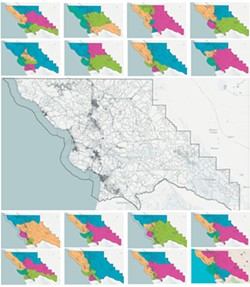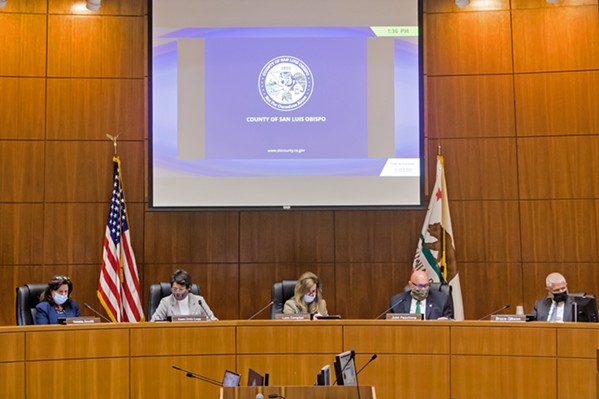Redistricting politics: SLO County supervisors consider new districts that could reshape local politics for the next decade
By Peter Johnson[{
"name": "Ad - Medium Rectangle CC01 - 300x250",
"id": "AdMediumRectangleCC01300x250",
"class": "inlineCenter",
"insertPoint": "8",
"component": "2963441",
"requiredCountToDisplay": "12"
},{
"name": "Ad - Medium Rectangle LC01 - 300x250",
"id": "AdMediumRectangleCC01300x250",
"class": "inlineCenter",
"insertPoint": "18",
"component": "2963441",
"requiredCountToDisplay": "22"
},{
"name": "Ad - Medium Rectangle LC09 - 300x250",
"id": "AdMediumRectangleLC09300x250",
"class": "inlineCenter",
"insertPoint": "28",
"component": "3252660",
"requiredCountToDisplay": "32"
}]
The San Luis Obispo County Board of Supervisors' conservative majority is mulling a significant redrawing of the county's supervisorial map as part of redistricting—with an eye on reducing how many districts touch the city of SLO, according to the three board members.
"In years past, the [Board of Supervisors] majority has always seemed to think it was OK to take the city and cut it into pieces," said Debbie Arnold, county supervisor for the 5th District, which covers mostly North County territory but also parts of SLO and Cal Poly. "I don't see the real connection between the student housing area of SLO and the city of Atascadero."
Removing SLO city from one or more county supervisor districts (it's currently in three) would trigger a set of cascading effects elsewhere on the county map because districts must have close-to-equal populations.
Politically, the change would more than likely bolster Republicans' advantage on the board, according to Cal Poly Political Science professor Michael Latner, who studies redistricting, as it bunches the city's mostly Democratic voters into fewer districts.
"Any of the maps where you see radical changes from the existing districts are clearly attempts to pack more Democrats into districts and get more Republican seats," Latner said.
The Board of Supervisors will meet on Nov. 19 at 9 a.m. for its third meeting about redistricting—the last meeting before the supervisors will vote on a final map at a Nov. 30 hearing. Once adopted, the map will chart the course of county politics for the next decade.
The board's majority members have been tight-lipped thus far about their opinions and positions on redistricting. In Nov. 12 phone calls with New Times, all three said they hadn't made up their minds on one specific map or district configuration.
But they made it clear that the current map is in trouble.
"I'd argue that the current map could be construed as gerrymandering," said 1st District Supervisor John Peschong, who represents Paso Robles, Templeton, and other areas of North County.
Arnold, Peschong, and 4th District Supervisor Lynn Compton all said they had issues with the current supervisorial map, adopted in 2011.
Their complaints centered on how many districts the city of SLO and Cal Poly are split into, which they said unfairly—and potentially unlawfully—divides SLO, disperses its voters across districts, and violates natural boundaries like the Cuesta Grade.
"I do honestly believe redistricting last time was done for political motives and unfairly," Compton said.
Of the three supervisors, only Peschong explicitly said he wants a new map that keeps all incorporated cities "whole," or represented by a single district and supervisor. But Compton and Arnold hinted at that notion—expressing an opposition to Arnold's 5th District dipping below the Cuesta Grade in SLO and Cal Poly.
"It just boggles my mind how that was done," Compton said.
Peschong, Arnold, and Compton emphasized that any new map must align with a new state redistricting law, the 2019 Fair Maps Act, which sets criteria for how counties should redistrict.
"There are new guidelines," Peschong said. "We're obviously trying to follow those guidelines."
One of the criteria of the Fair Maps Act is to keep incorporated cities within one district as much as practically possible.
But another criterion—a higher-ranking criterion, according to the law—is to avoid fracturing "communities of interest," a term defined as "a population that shares common social or economic interests."
Minority Supervisors Bruce Gibson (2nd District) and Dawn Ortiz-Legg (3rd District), both Democrats, are against making any significant changes to the current map, in part because of how it will break up communities of interest elsewhere in the county.
The League of Women Voters of SLO County, a nonpartisan political organization, shares that view.
"We really want to stress that the move to put the city of SLO in one district impacts communities of interest throughout the county," the League's Voter Service Director Julie Rodewald said during a Nov. 8 webinar about county redistricting.
In a few draft maps that attempt to unify SLO into one district, Gibson's 2nd District—which touches SLO but covers mostly the North Coast, from Los Osos to San Simeon—is then broken up into multiple districts.
Gibson, and many of his constituents, have come out strongly against that proposal.
"The North Coast has been a community of interest for decades," Gibson told New Times. "It's been represented by one supervisor for as far back as anybody can remember. On the face of it, trying to unify SLO, to the extent it fractures communities of interest elsewhere, is not compliant with state standards."
Gibson added that the city of SLO has also been split into multiple districts "going back decades."
Having that jigsaw puzzle is logical, according to Ortiz-Legg, given SLO's large population and status as the county seat and economic center.
"The county seat should be in more than one district. I think that's just out of common sense," said Ortiz-Legg, who represents portions of SLO and the coastal towns of Avila Beach, Pismo Beach, and Grover Beach.
Ortiz-Legg told New Times that she doesn't see any valid reason to make major changes to the district lines.
"We have pretty competitive [supervisor] races. Why do we need to change the map at all?" she asked.
According to SLO County's redistricting consultant, Redistricting Partners, the board doesn't need to make significant changes to the map. The county population distribution across the five current districts—although on the high end of the state's allowable percentage deviation—meets legal standards.
According to Latner, the Cal Poly professor, any attempt to isolate SLO into a single district can only be construed as a political attempt to create a "sink" district: a district that holds a large number of Democratic voters, which in turn gives Republicans a countywide advantage.
"You're giving them that district so you can control the remaining districts," Latner said. "I'd argue you should probably have some piece of every district in SLO city. It is the county seat and the most populous city in the county."
The board's majority denied that it intended to gerrymander the county for partisan gain.
"I don't agree with that statement at all. This isn't about politics," Arnold said.
"I'm very aware that we need to make sure that it's not gerrymandered," added Peschong. "I don't believe that any map the board supports will be a gerrymandered map."
Compton, whose South County district includes Arroyo Grande, Oceano, and Nipomo, said she's still undecided about what potential changes she could support to her own district lines. She faces a tough election rematch next year against Arroyo Grande City Councilmember Jimmy Paulding, who she beat by just 60 votes in a 2018 election.
She said she remains "open to anything," but doesn't think the current map "passes muster" on a legal level.
"I'm sure no matter what we do we'll make some people happy, and some people unhappy," Compton said. "I promise I'll do it in a legal way. I think it'd be really foolish to carve it up if it couldn't support a legal challenge." Δ
Assistant Editor Peter Johnson can be reached at [email protected].
Latest in News
Comments
Showing 1-1 of 1
Readers also liked…
-

Coast Unified teachers upset over new position's salary and qualifications
Oct 20, 2022 -

SLO police identify alleged driver who hit and killed couple
Dec 22, 2022 -

When the levee breaks: Oceano residents, county officials walk a tightrope of regulations to manage Arroyo Grande Creek, which some say led to the levee's failure in January
May 18, 2023











